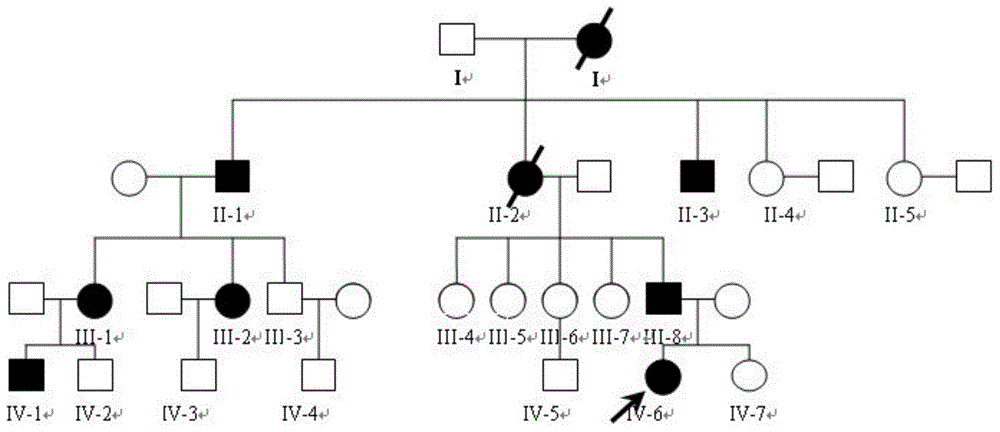CC (congenital cataract) PITX3 gene novel mutation
A congenital cataract and genetic technology, applied in genetic engineering, plant genetic improvement, animal/human peptides, etc., can solve the problems of high cost and achieve the effect of perfecting and enriching the diagnostic process
- Summary
- Abstract
- Description
- Claims
- Application Information
AI Technical Summary
Problems solved by technology
Method used
Image
Examples
Embodiment 1
[0044] In this example, a new generation of whole exome sequencing technology was used to perform high-throughput sequencing of all exome regions in a Chinese Han family with autosomal dominant inheritance of congenital cataract. Combined with bioinformatics analysis, it was found that PITX3 The c.608delC (p.A203fs) mutation in the gene is related to congenital cataract (CC), and this variation was verified by co-segregation experiments and other methods.
[0045] 1. Sample collection
[0046] The congenital cataract family contains 30 members, including 9 congenital cataract patients ( figure 1 ). In the family, 3 patients with congenital cataract and 1 normal control were selected as exome sequencing samples (Table 1). 2 ml of peripheral blood samples were collected from each sample, anticoagulated with EDTA, and stored at -80 degrees Celsius. Later, 4 patients and 4 normal control individuals in the family were collected as secondary verification samples (Table 2). 2ml of...
Embodiment 2
[0096] As a further verification of Example 1, the following examples are provided.
[0097] 1 Sample preparation
[0098] The peripheral blood of 12 samples (7 patients and 5 controls) in the cataract family was collected, and the genomic DNA in the peripheral blood leukocytes was extracted by the conventional phenol-chloroform method, and the concentration and purity of the DNA were measured by a spectrophotometer. The OD260 / OD280 of the genomic DNA of the specimen is between 1.7-2.0, the concentration is not less than 200ng / ul, and the total amount is not less than 30μg.
[0099] 2 Gene detection of disease-causing mutations
[0100] The PITX3 gene deletion site of 12 samples (7 patients and 5 controls in Table 1 and Table 2) was detected, primers were designed for the sequence near the deletion site detected by this known gene, and the product was amplified by PCR. Purification and sanger sequencing methods are used to obtain relevant sequences near the deletion site, an...
Embodiment 3
[0125] Kit 1: a kit for detecting the mutation PITX3 gene, comprising one or more sets of primer pairs, wherein the mutation is the mutation c.608delC of the PITX3 gene or the mutation p.A203fs of the PITX3 protein, wherein the primer pairs are selected based on Design on the genome sequence or the cDNA coding region sequence from the following position, so that the amplified product covers this position: the 608th position of the cDNA coding region sequence of the PITX3 gene, and the kit for detecting the mutant PITX3 gene includes the following primers:
[0126] SEQ ID NO:5 and SEQ ID NO:6.
[0127] Kit 2: a kit for detecting the mutant PITX3 gene, comprising one or more nucleic acid probes, the mutation is the mutation c.608delC of the PITX3 gene, and the genome sequence of the probe and the mutant PITX3 gene is selected from the following positions Or complementary to the region on the cDNA coding region sequence: the 608th position of the PITX3 gene cDNA coding region seq...
PUM
 Login to View More
Login to View More Abstract
Description
Claims
Application Information
 Login to View More
Login to View More - R&D
- Intellectual Property
- Life Sciences
- Materials
- Tech Scout
- Unparalleled Data Quality
- Higher Quality Content
- 60% Fewer Hallucinations
Browse by: Latest US Patents, China's latest patents, Technical Efficacy Thesaurus, Application Domain, Technology Topic, Popular Technical Reports.
© 2025 PatSnap. All rights reserved.Legal|Privacy policy|Modern Slavery Act Transparency Statement|Sitemap|About US| Contact US: help@patsnap.com



